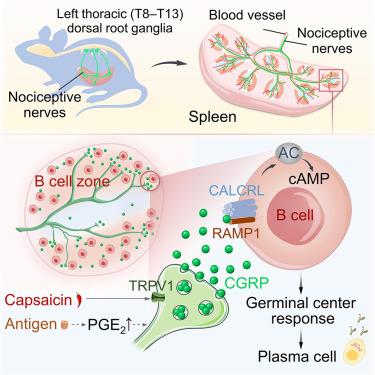Cell ( IF 45.5 ) Pub Date : 2024-05-20 , DOI: 10.1016/j.cell.2024.04.027 Min Wu 1 , Guangping Song 2 , Jianing Li 1 , Zengqing Song 1 , Bing Zhao 1 , Liyun Liang 2 , Wenlong Li 3 , Huaibin Hu 1 , Haiqing Tu 1 , Sen Li 1 , Peiyao Li 2 , Biyu Zhang 1 , Wen Wang 1 , Yu Zhang 4 , Wanpeng Zhang 1 , Weifan Zheng 1 , Jiarong Wang 1 , Yuqi Wen 1 , Kai Wang 1 , Ailing Li 1 , Tao Zhou 1 , Yucheng Zhang 1 , Huiyan Li 1

|
Peripheral sensory neurons widely innervate various tissues to continuously monitor and respond to environmental stimuli. Whether peripheral sensory neurons innervate the spleen and modulate splenic immune response remains poorly defined. Here, we demonstrate that nociceptive sensory nerve fibers extensively innervate the spleen along blood vessels and reach B cell zones. The spleen-innervating nociceptors predominantly originate from left T8–T13 dorsal root ganglia (DRGs), promoting the splenic germinal center (GC) response and humoral immunity. Nociceptors can be activated by antigen-induced accumulation of splenic prostaglandin E2 (PGE2) and then release calcitonin gene-related peptide (CGRP), which further promotes the splenic GC response at the early stage. Mechanistically, CGRP directly acts on B cells through its receptor CALCRL-RAMP1 via the cyclic AMP (cAMP) signaling pathway. Activating nociceptors by ingesting capsaicin enhances the splenic GC response and anti-influenza immunity. Collectively, our study establishes a specific DRG-spleen sensory neural connection that promotes humoral immunity, suggesting a promising approach for improving host defense by targeting the nociceptive nervous system.
中文翻译:

脾脏中伤害感受器神经元的神经支配促进生发中心反应和体液免疫
周围感觉神经元广泛支配各种组织,以持续监测和响应环境刺激。外周感觉神经元是否支配脾脏并调节脾脏免疫反应仍不清楚。在这里,我们证明伤害性感觉神经纤维沿着血管广泛支配脾脏并到达 B 细胞区域。支配脾脏的伤害感受器主要起源于左侧 T8-T13 背根神经节 (DRG),促进脾生发中心 (GC) 反应和体液免疫。抗原诱导脾脏前列腺素E 2 (PGE 2 )积累可激活伤害感受器,释放降钙素基因相关肽(CGRP),进一步促进脾脏早期GC反应。从机制上讲,CGRP 通过其受体 CALCRL-RAMP1 通过环 AMP (cAMP) 信号通路直接作用于 B 细胞。通过摄入辣椒素激活伤害感受器可增强脾脏 GC 反应和抗流感免疫力。总的来说,我们的研究建立了一种特定的 DRG-脾感觉神经连接,可促进体液免疫,这提出了一种通过针对伤害性神经系统来改善宿主防御的有前途的方法。













































 京公网安备 11010802027423号
京公网安备 11010802027423号